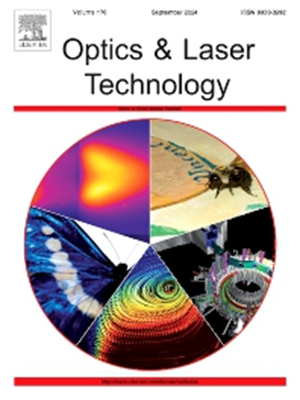Rapidly and widely repetition-rate-tunable free-running dual-comb fiber laser with a bidirectional polarization-multiplexing configuration
IF 4.6
2区 物理与天体物理
Q1 OPTICS
引用次数: 0
Abstract
Repetition-rate-tunable fiber lasers are practical in addressing aliasing issue and exploring optimization parameters for dual-comb metrology and 3D surface profilometry. However, the tuning speed of typical delay lines is not very high, which limits the frame rate. Meanwhile, wide-range tunability is desired to extend non-ambiguity distances and eliminate dead zones. Here, we developed a dual-comb fiber laser based on a resonate piezoelectric motorized delay line that shows a tuning speed up to 493.5 kHz/s over 329-kHz tuning range, which is the fastest to the best of our knowledge. Benefiting from the mechanically shared polarization-maintaining oscillator, the proposed laser is stable with low crosstalk in full free-running, while this bidirectional polarization multiplexing configuration endows good flexibility and tunability. Consequently, the 1-hour variation of repetition rate difference is 0.52 Hz, with a standard deviation of 0.10 Hz. The dual combs are further pulled closer to 184.5 Hz by roughly compensating for fiber length. These results demonstrate a promising solution for developing accordion-comb seed light sources that can contribute to dual-comb metrology and 3D surface profilometry.
求助全文
约1分钟内获得全文
求助全文
来源期刊
CiteScore
8.50
自引率
10.00%
发文量
1060
审稿时长
3.4 months
期刊介绍:
Optics & Laser Technology aims to provide a vehicle for the publication of a broad range of high quality research and review papers in those fields of scientific and engineering research appertaining to the development and application of the technology of optics and lasers. Papers describing original work in these areas are submitted to rigorous refereeing prior to acceptance for publication.
The scope of Optics & Laser Technology encompasses, but is not restricted to, the following areas:
•development in all types of lasers
•developments in optoelectronic devices and photonics
•developments in new photonics and optical concepts
•developments in conventional optics, optical instruments and components
•techniques of optical metrology, including interferometry and optical fibre sensors
•LIDAR and other non-contact optical measurement techniques, including optical methods in heat and fluid flow
•applications of lasers to materials processing, optical NDT display (including holography) and optical communication
•research and development in the field of laser safety including studies of hazards resulting from the applications of lasers (laser safety, hazards of laser fume)
•developments in optical computing and optical information processing
•developments in new optical materials
•developments in new optical characterization methods and techniques
•developments in quantum optics
•developments in light assisted micro and nanofabrication methods and techniques
•developments in nanophotonics and biophotonics
•developments in imaging processing and systems

 求助内容:
求助内容: 应助结果提醒方式:
应助结果提醒方式:


